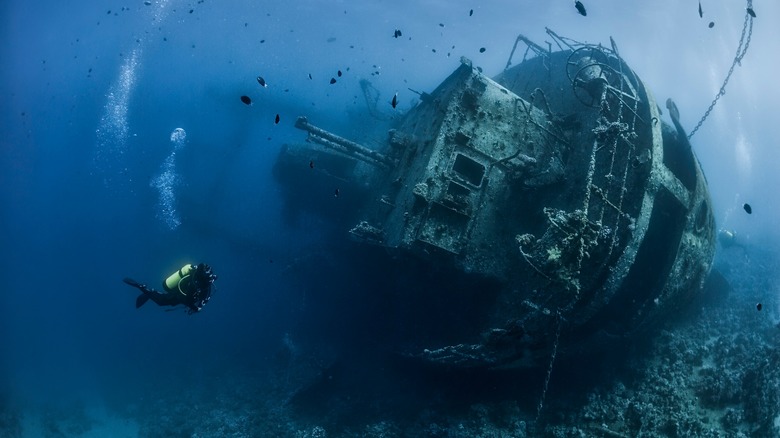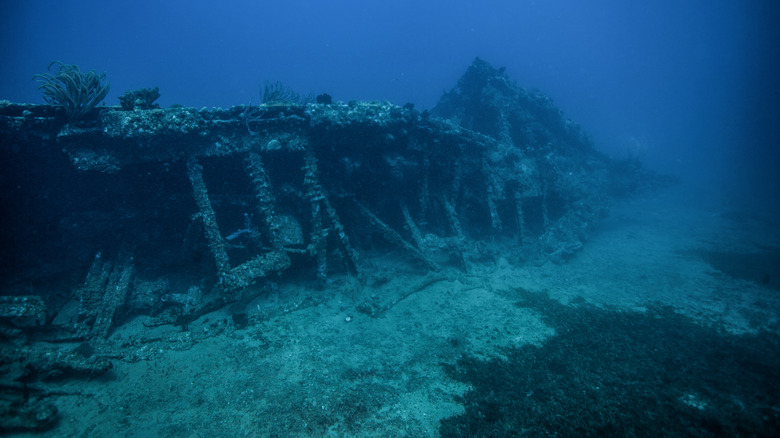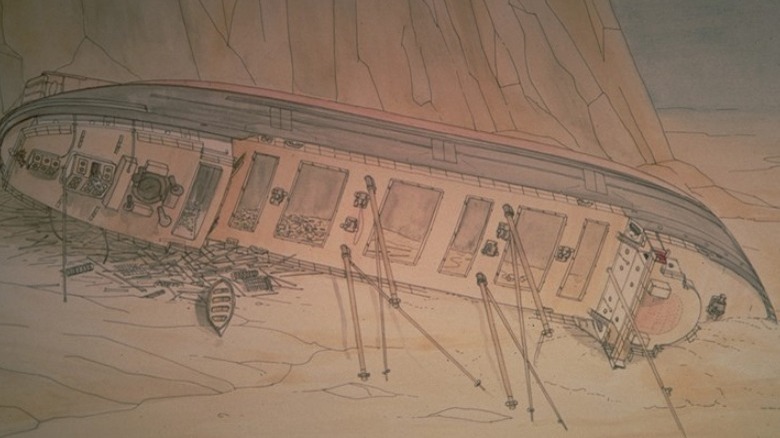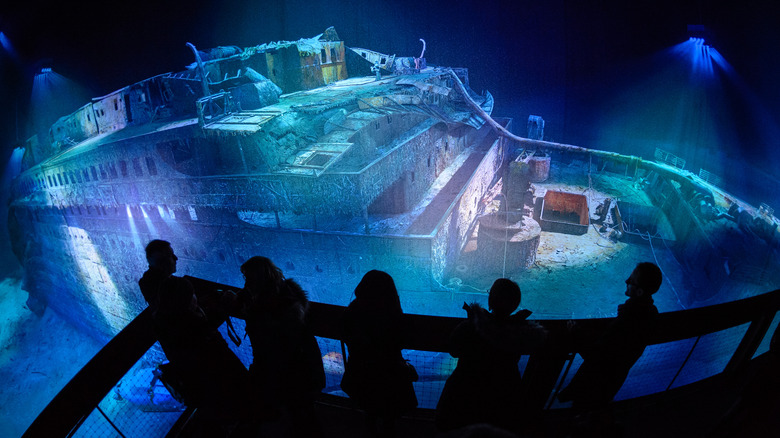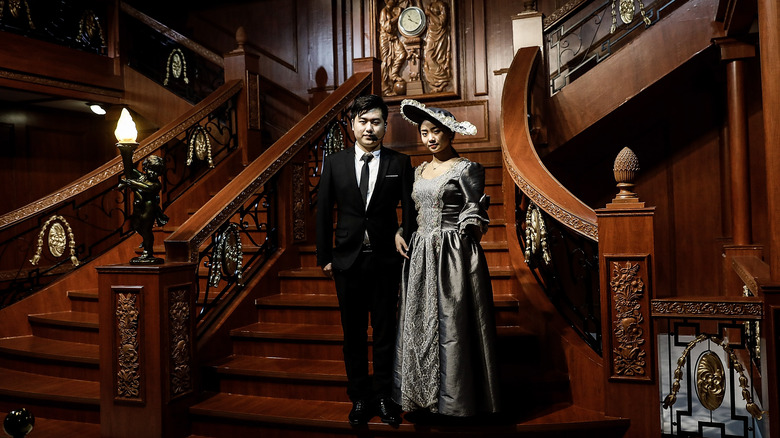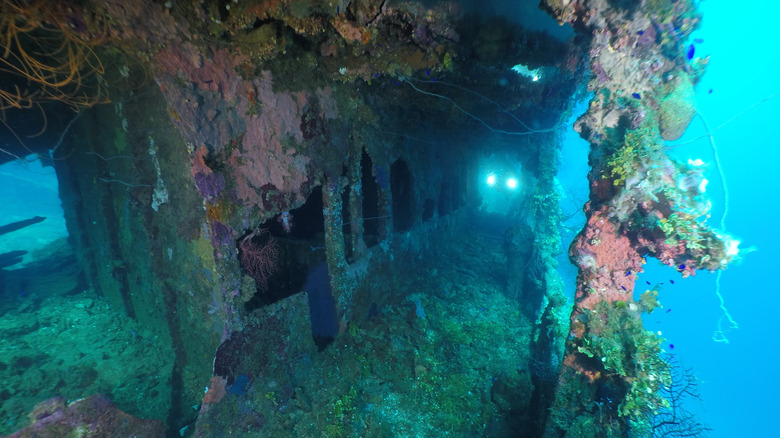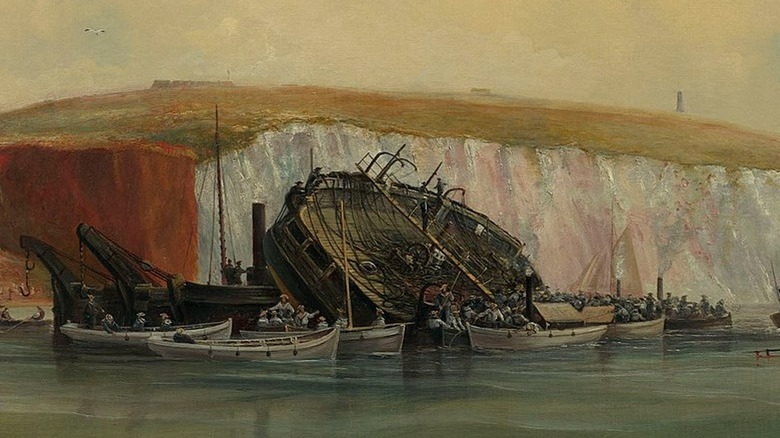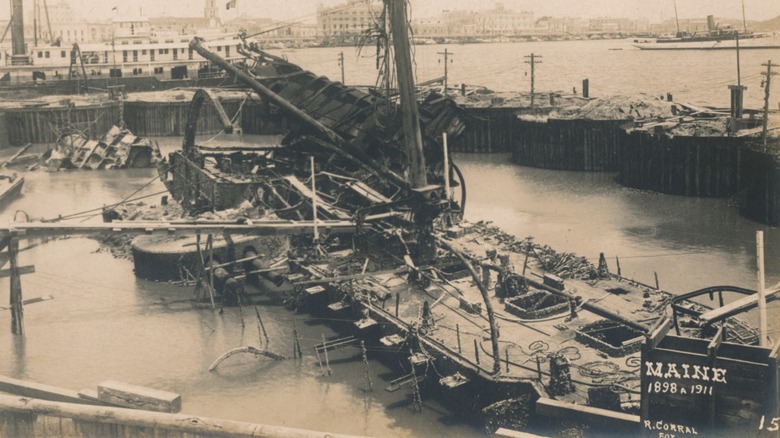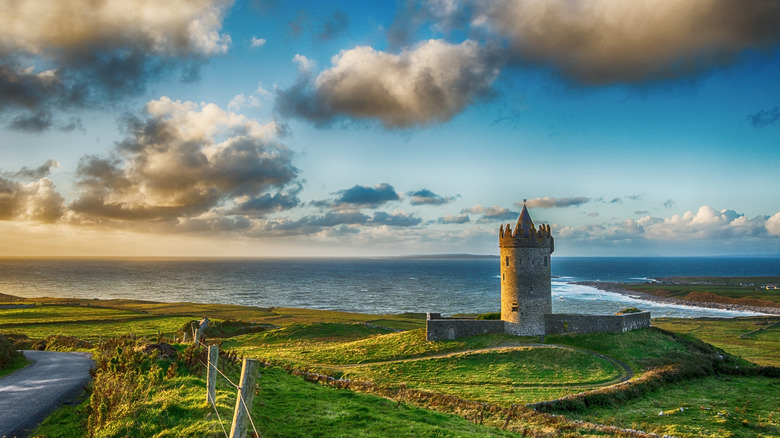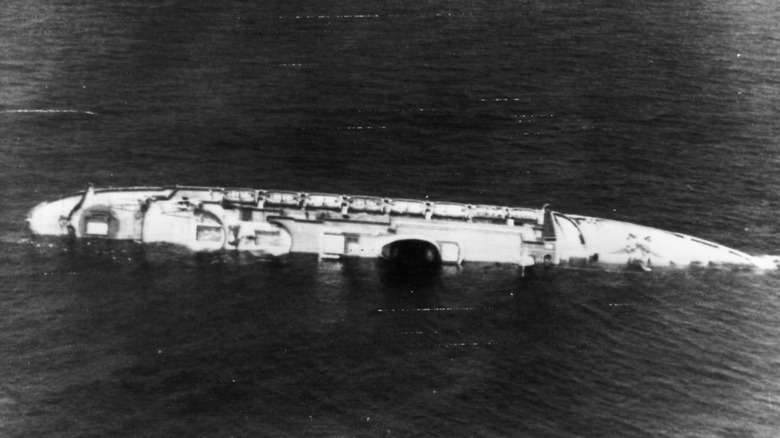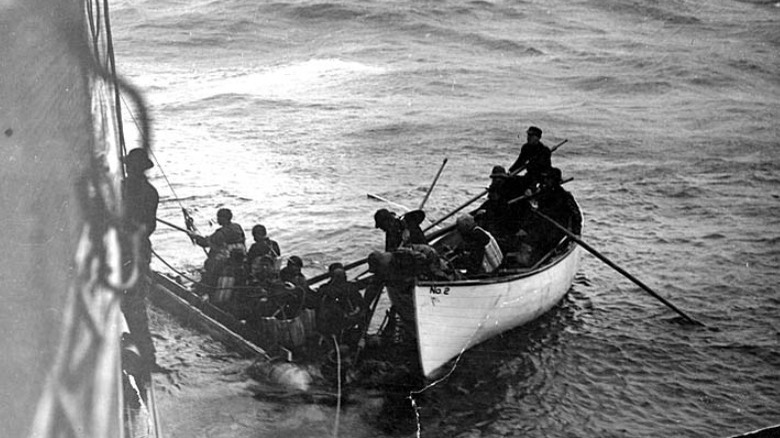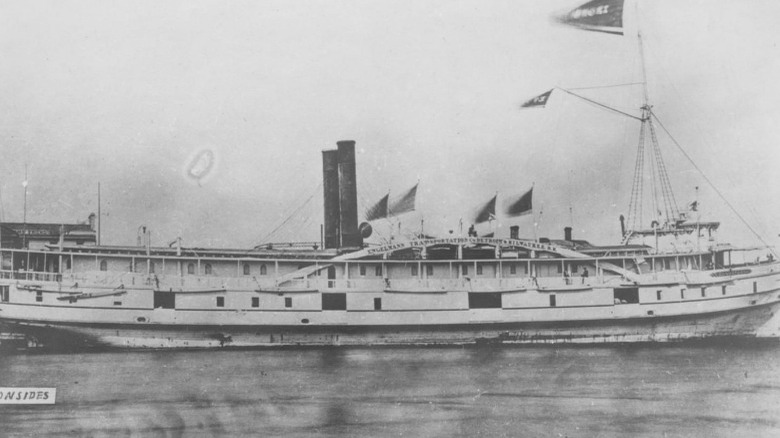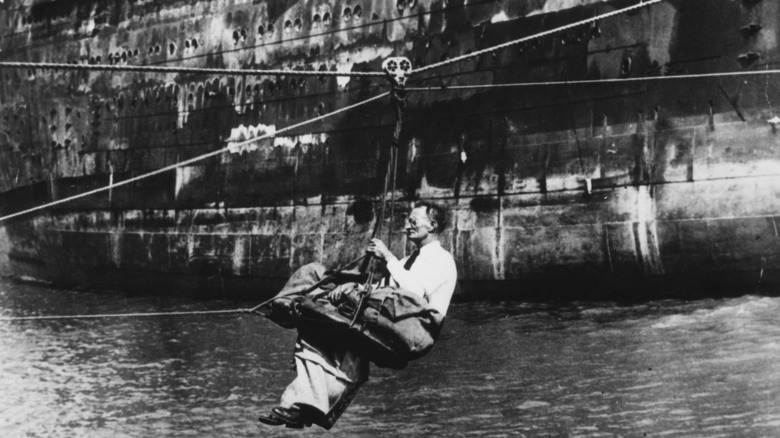Shipwrecks That Are Said To Be Haunted
If any place in the world is haunted, it's probably the planet's oceans. Aside from what nightmarish monstrosities have already been pulled up from the depths, there's also the fact that it's estimated there are somewhere in the neighborhood of 3 million shipwrecks littering the ocean floor. Popular Mechanics puts that in perspective and says that when search efforts were underway for Malaysia Airlines Flight 370, they found two previously undiscovered shipwrecks first.
They go on to say that it's estimated that only about 10% of those shipwrecks have been discovered and mapped, and even those that we know about haven't all been explored. Experts from the National Oceanic and Atmospheric Administration say that within the boundaries of their 14 Marine Sanctuaries, there's around 4,300 shipwrecks, with only 432 being thoroughly documented.
And there's just something about shipwrecks, isn't there? A crew looking out over a raging ocean, who might as well be sailing along into oblivion. A crew at the mercy of the sheer, unforgiving power of Mother Nature, facing the imminent reality of a watery grave. Seriously, it's no wonder stories of hauntings have grown up around shipwrecks.
The RMS Rhone
Calling anything "indestructible" or "unsinkable" is just asking for trouble, and according to Sail Caribbean, the RMS Rhone was dubbed the latter by the British Royal Navy. Needless to say, it sank. It was Oct. 29, 1867, and two ships — the RMS Conway and the larger Rhone — were anchored in the West Indies, at Peter Island's Great Harbor. All signs seemed to point to a storm moving in, but the two ships' captains decided that everyone would wait out whatever was coming in on the "unsinkable" Rhone.
It wasn't just a freak storm, it was a Category 3 hurricane. By the time they realized just how dire things were, it was too late ... at least, for the Rhone. After getting her anchor lodged in a coral reef, the Rhone chugged her way onward to safety ... only to get picked up and smashed against Black Rock Point.
The captain's coral-covered teaspoon — which he was using to make himself a congratulatory cup of tea when tragedy struck — is still part of the wreck. So, says Pure Breaks, are the souls of those the reportedly unsinkable ship dragged down with it. Of the 146 passengers, only 23 survived: Divers who have explored the surprisingly accessible wreck claim to have felt hands reaching out to touch them as they swam through the wreck, while others have heard what sounds like eerily human screams. The sounds of the ocean ... or of the dead?
The SS Kamloops
So here's something that's impossible to un-know: The cold waters of the Great Lakes preserve the bodies that aren't recovered from their hundreds and hundreds of shipwrecks. Where the wreck of the USS Kamloops came to rest after it sank in a December storm in 1927, it's too cold and dark to support the bacteria that are usually responsible for decay, which — according to 98.7 FGR Grand Rapids — means that one sailor is still there.
That's not in a metaphorical sense, either. Divers have taken a single photo of him, and the Week in Weird recounts stories that suggest the spirit of the man — who is perfectly preserved, and called Old Whitey or Grandpa — is still there, too. Some say that they've seen him wandering through the ship, going about his business as though it's still floating on the surface. Others have stumbled across him laying in his bunk, where he's not sleeping, but just sort of silently watching the divers gliding through his final resting place. Not terrifying enough? Still other divers swear that he followed them as they swam, occasionally reaching out to touch them.
Divers who have met him unanimously say there are no feelings of anger there, and they don't feel threatened by him. If anything, they say that he seems content to finally have some company, deep in the dark, freezing waters, and some have all repeated a heartbreaking detail: When he reaches out, they notice that he's still wearing his wedding ring.
The Titanic
After sinking in 1912, the Titanic was discovered in 1985: According to National Geographic, the reportedly unsinkable ocean liner's final resting place is on the sea floor near Newfoundland, 12,500 feet beneath the surface.
Still, the general area of the Titanic's sinking was known for a long time, and according to Mysterious Universe, one of the best hauntings dated to 1977. The story goes that the SS Winterhaven was passing through the same area where the Titanic sank, and an officer named Leonard Bishop struck up a conversation with a passenger. He gave the man a tour of the ship, and never forgot the man's face or his intense interest in every technicality of the Winterhaven. Years later, he saw the man's picture and pointed him out as his passenger: It was the Titanic's Captain Edward John Smith.
Bishop isn't the only person to report seeing Smith, other ships passing through the area have reported seeing him wandering their decks. Even those who haven't gotten up close and personal with the former captain have reported other phenomena in the area: Boroughs of the Dead says that passing ships have also reported orbs dancing over the water, and others have experienced unexplained interference with their communications systems. Some have even received distress calls, including SOS and CQD — or "Come Quick, Danger" — that were used by the Titanic in her last moments.
The Titanic: Part 2
After the discovery of the Titanic's final resting place at the bottom of the Atlantic, not all of it has stayed there. Salvage companies have plucked treasures from the wreckage and the sea floor around it, and according to The Washington Post, a company called Titanic Ventures recovered around 1,800 objects in a series of dives in 1987 and 1991. Not everyone was thrilled with it, yet here we are. Around 300 artifacts taken from the wreck went on tour with a show called "Titanic: The Artifact Exhibition," and according to those who went to see the artifacts or worked with the show (via Mysterious Universe), salvage teams brought more than artifacts to the surface.
Bizarrely, it's one of the survivors who's said to still walk the recreation of the Promenade Deck amid the artifacts reclaimed from the wreck. Frederick Fleet was the first to see the iceberg, and although he was rescued, he later died by suicide. A woman in period dress is often seen on the exhibit's staircase (pictured), and one employee, in particular, says he's constantly poked, prodded, and whispered to by spirits attached to the artifacts.
It's not an isolated incident, either, and those working with a similar collection of artifacts at the Georgia Aquarium also report hearing strange noises, feeling ghostly hands, and seeing the specter of an old woman who apparently lives in their replica cabin.
The shipwrecks of Truk Lagoon
During World War II, the Allies embarked on a campaign of island-hopping in order to get closer and closer to the Japanese mainland. It was during this campaign that — on February 17, 1944 — a group of Allied carriers, ships, and aircraft unleashed hell on the ships of the Japanese fleet that were stationed at Truk Lagoon. By the time it was over, around 40 ships were sunk. Atlas Obscura says that the site was largely forgotten about until Jacques Cousteau filmed a documentary there in 1969, and the area — now officially called Chuuk — is still a massive ships' graveyard.
And yes — according to Sport Diver Magazine — divers who have explored the wrecks have seen some eerie, unexplainable things. One diver recounted a story about exploring the wrecks with a friend, but when he swam into one, his friend stayed outside. When he asked him why he hadn't gone in later, his friend had said that there were already too many people swimming through the wreck. The first diver, however, clarified: He had been alone. Hadn't he?
Local guides say they have no doubts that the spirits of the hundreds of men who died that day are still there. Human-shaped shadows are frequently seen among the wrecks, along with flickering lights. Local devotees of Shintoism say that although some remains have been reclaimed and given proper funeral rites, there are plenty of bones still among the wrecks, they'll continue to haunt the ships where they perished.
The HMS Eurydice
According to the BBC, the HMS Eurydice was refloated the year after she sank off the coast of Portsmouth. There was too much damage, though, and she was ultimately destroyed. However, those who have seen her still sailing near where she sank say that she's not entirely gone after all.
The sinking of the Eurydice is still considered one of the worst peacetime disasters in British maritime history. It was March 22, 1877, when the ship approached Britain after crossing the Atlantic, and a storm of blinding, freezing rain and snow moved through in just around 20 minutes. With gun ports open, the ship didn't stand a chance. When the storm cleared after about 10 minutes, all that remained were pieces of the upper rigging.
According to The News of Portsmouth, countless people claim to have seen the Eurydice still sailing off the coast where she sank, including Prince Edward. He described the 1977 sighting that happened during filming for a TV series: "We were talking about a ghost ship on the Isle of Wight, and how we could illustrate this three-masted schooner that just disappears. Suddenly someone said, 'Look, there's one now,' and sure enough, out to sea, there was a three-masted schooner." It disappeared as quickly as it appeared, and others have seen it, too — including a submarine that had to quickly adjust course to avoid hitting it ... before it vanished.
The USS Maine
When the USS Maine was sunk in the harbor of Havana, Cuba, on February 15, 1898, she ushered in the Spanish-American War (via History). The explosion claimed around 260 lives, and as verified by NavSource, one of the ships tasked with salvaging the wreck was a tug called the Right Arm, under the command of John Magee, Jr. Magee stepped in after Spanish teams had repeatedly and inexplicably failed to investigate the ship: Divers stayed under for only minutes, then walked off the site and never returned. It happened again and again until, finally, Magee interrogated one of the divers.
The wreck, the diver said, was "infested" with the spirits of those who had died on board, reaching out to anyone who came close, pleading for someone to recover their remains, bury them, and let them pass on to peace.
The story — told by the Journal of the Bizarre — gets weirder. Just after the destruction of the Maine, the Buffalo Sunday Morning News ran a story about one ghost in particular. Divers said that he was wearing a lieutenant's uniform, and his face was obscured by darkness. And here's the thing: The explosion happened when most of the men were asleep and definitely not in uniform ... except for one Lieutenant Friend W. Jenkins. A survivor — George FW Holman — wrote a letter to Jenkins's sister, and said that not only had he been with the man when the explosion happened, but that he had been dressed in his full uniform — a detail divers couldn't have known.
Doonagore's Spanish Armada sailors
Not far from the Cliffs of Moher on Ireland's west coast stands Doolin Castle. The castle overlooks a beach, says The Irish Road Trip, and according to old lore, that beach was where one of the ships of the ill-fated Spanish Armada ended up smashing itself on the rocks.
It was 1588, and around 170 members of the crew managed to make it off the wreck and onto the nearby beach ... which is where Archaic Wonder says things take an even darker turn. The survivors were immediately arrested by the county's high sheriff, a man named Boetius MacClancy. He ordered them all hanged, and they were — while they were buried near Doolin, legend says that they still haunt the beach where their twice-condemned ship was wrecked.
Interestingly, this is a story with some serious substance to it. According to the "Mason's Parochial Survey, 1814 to 1819", the burial place of the doomed sailors was well-marked, known as Taumple na Spanigg, or "burial place of the Spaniards." At least one piece of the shipwreck was also reclaimed: Sitting in Dromoland House was an exquisite desk made from an oak table that had been on board the ship, originally owned by the sheriff that had hanged the doomed survivors.
The Andrea Doria
Global Underwater Explorers says that as far as shipwrecks go, the Andrea Doria isn't unlike Mt. Everest for mountain climbers. That's no joke: The ship sank off the Massachusetts coast after a collision with the Stockholm, and years later, it's still claiming lives. Scuba Diving says that at least 16 divers have died there, and others? They've reported some eerie things.
But first, some background on what's down there. In 2016, Hometown Life reported on the story of one of the survivors. Pierette Simpson had been 9 years old when she boarded the ship at the start of a grand adventure: Emigration from war-torn Italy for the promised land that was America. She was terrified to fly, she recounted, and instead ... she sank on July 25, 1956. The sinking was slow, and while many people were able to make it to safety, it still claimed 46 lives.
Unpredictable currents and poor visibility have been the official cause of the deaths of the 16 divers that have perished there since then, but many report seeing strange figures moving through the silt- and sediment-heavy waters. Some claim to have seen things partially obscured by dive masks, which vanish when they turn, and still others claim to have felt hands reaching out to grab them as they swim. Are 46 souls still hoping to be rescued?
The SS Valencia
The SS Valencia wrecked off the coast of Vancouver in 1906, but according to Atlas Obscura, pieces of the wreckage are still laying on the beach — which is a part of a particularly dangerous section of coastline ominously called the Graveyard of the Pacific. After being battered by a storm that ripped a hole in her side, the ship was run aground onto the beach, and many — without the captain's orders — fled to lifeboats, which were tossed about like dolls on a tidal wave. The final death toll was 136, and no women or children survived.
One of the 37 men who survived, Frank Lehn, later wrote (via Moon Mausoleum): "Screams of women and children mingled in an awful chorus with the shrieking of the wind, the dash of the rain, and the roar of the breakers. As the passengers rushed on deck, they were carried away in bunches by the huge waves that seemed as high as the ship's mastheads."
Those who made it to those ill-fated lifeboats didn't stand a chance. Some were crushed between the waves and the sides of the Valencia, while others immediately capsized when they hit the water. Some just disappeared, but those who have visited the wreck site have claimed to have seen some of the lifeboats, out in the water, their occupants still rowing furiously in an attempt to reach the safety of the shore they had been just a stone's throw from.
Ironsides
The steamer called Ironsides was launched in 1864, and according to Milwaukee Magazine, she boasted all kinds of luxuries like both hot and cold running water. She looked great on the surface, but the parts passengers didn't see were old, leaky, and in dire need of repair. When she set sail into September weather that would quickly turn stormy on that ill-fated night in 1873, it didn't take long for things to go horribly wrong. The hull started to crack, pumps failed, and when the crew and passengers made it into the five lifeboats, three capsized. After the storm, rescue workers could start pulling bodies from the icy waters of Lake Michigan.
Two of those people were Nettie Valentine and her son, Henry. When Henry's body was recovered, he was placed in a coffin with his mother and returned to Milwaukee, but legend says that he never really left.
Those out on the lake say they've heard him crying for help, and on Aug. 6, 2000, the crew of the Coast Guard ship Mackinaw heard a child's cries for help. The icebreaker summoned a rescue boat, but crews were unable to find anyone nearby. There were no reports of missing children or ships, no requests for any kind of aid, and no storms. It was only later that they realized they had been over the wreck of Ironsides, with believers saying they had heard little Henry Valentine, still calling for help.
The Morro Castle
According to Only in Your State, the Morro Castle's journey from Havana to New York started with a building storm and continued with the death of her captain. Then, a fire started, and the now captain-less ship floundered in attempts to get passengers onto lifeboats, get lifeboats into the water, and send distress calls. What washed up on the New Jersey shore hot far from the Asbury Park Convention Center was a grisly mix of bodies and a boat that was still on fire, stranded crew and passengers silhouetted against the flame.
That was in September of 1934, and Atlas Obscura says that it was six months before the wrecked liner was finally hauled away. Tourists that flocked to see it in the meantime got more than they bargained for, and some say that those visiting the beach can still hear the screams of those who died in the wreck. Visitors today also report seeing a ghostly ship run aground in the shallows and see shadowy human forms on the beach. And here's the thing: Are they passengers of the Morro Castle? Or of the New Era?
That, says USA Today, is the ship that wrecked in the exact same spot on Nov. 13, 1854. Caught in a storm, the New Era ran aground and ultimately brought with it a death toll of around 240 people — many of whom froze to death when they were trapped on the grounded ship in the stormy night.
